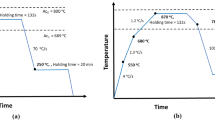Conclusions
-
1.
Microdefects are formed in two stages during creep of ferritic — martensitic and austenitic steels. The larger the number of defects in the metal at the end of the first stage, the higher the rate of accumulation of damage in the second stage.
-
2.
The rate of accumulation of defects in the grain boundaries depends on the condition of the grains. Increasing the strength of the grains by heat treatment of the steel may reduce the damage by a factor of three to five.
-
3.
There is an optimal ratio between the strength of grains and the strength of boundaries that ensures the least number of defects.
Similar content being viewed by others
Literature cited
V. I. Betekhtin, V. N. Savel'ev, and A. I. Petrov, "Rate of accumulation of microscopic discontinuities during fatigue and creep tests of aluminum," Fiz. Met. Metalloved.,38, No. 4, 834 (1974).
B. Cahe and G. Greenwood, Metal Science,9, 55 (1975).
V. M. Rozenberg, A. V. Shalimova, and T. S. Zvereva, "Effect of temperature and stress on formation of pores during creep," Fiz. Met. Metalloved.,25, No. 2, 326 (1968).
V. I. Kumanin, I. I. Trunin, and R. B. Bogomol'naya, "Accumulation of defects during creep at high temperatures," in: Diffusion, Phase Transformations, and Mechanical Properties of Metals and Alloys [in Russian], VZMI, Moscow (1973), p. 55.
C. Fessati, R. Mattera, and G. Piatti, Microstructure and Design Alloys, Vol. 1, Cambridge (1973), p. 218.
A. Perry, J. Mater. Sci.,9, No. 6, 1016 (1974).
D. Japlin, Metals Eng. Q.,10, No. 1, 31 (1970).
M. F. Sheshenev, V. I. Kumanin, and B. É. Shkol'nikova, "Effect of structure on properties of steel 1Kh12V2MF," Metalloved. Term. Obrab. Met., No. 6, 8 (1973).
I. L. Mirkin, R. P. Zaletaeva, and I. I. Apukhtina, "Long-term plasticity of austenitic steel," Teploénergetika, No. 10, 80 (1973).
L. A. Kovaleva and V. I. Kumanin, "Determination of heat resistance by means of precision determination of density," in: Effect of Structure on Development of Defects in Heat Resistant Steels [in Russian], NIIINFORMTYaZhMASh, 14-7614, Moscow (1976), p. 7.
V. F. Zlepko et al., "Defects in steam pipes of steel 12Kh1MF under creep conditions," in: Operational Reliability of Metals in Power Plants [in Russian], Energiya, Moscow (1975), p. 28.
E. I. Krutasova, G. M. Novitskaya, and G. A. Bologov, "Structural changes in pipe of steel 12Kh1MF under creep conditions," Metalloved. Term. Obrab. Met., No. 7, 6 (1976).
H. Evans, Phil. Mag.,23, No. 185, 1101 (1971).
Additional information
All-Union Correspondence Machine Construction Institute. Translated from Metallovedenie i Termicheskaya Obrabotka Metallov, No. 11, pp. 20–23, November, 1977.
Rights and permissions
About this article
Cite this article
Kumanin, V.I., Shkol'nikova, B.É. & Apukhtina, I.I. The two stages in which defects accumulate in heat-resistant materials. Met Sci Heat Treat 19, 940–943 (1977). https://doi.org/10.1007/BF00670161
Issue Date:
DOI: https://doi.org/10.1007/BF00670161




